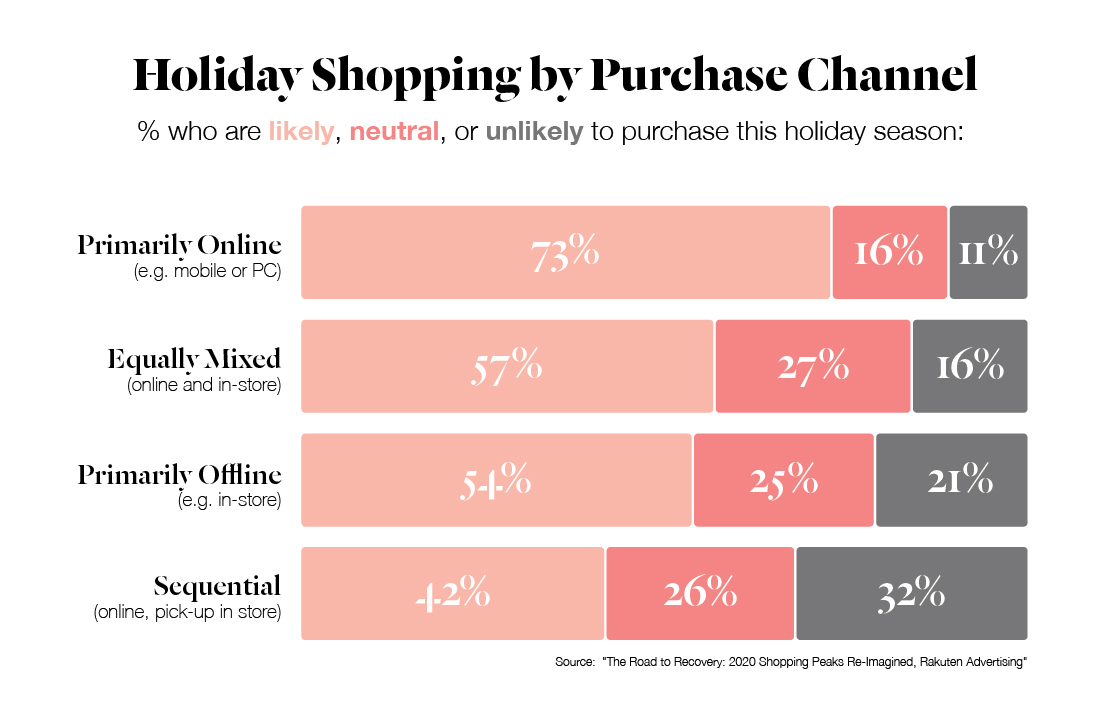5 Retail Strategies For Sucess This 2020 Holiday Shopping Season


What a difference a single year can make in our lives! 2020 has been a reset button for the global population to reboot and redesign the way we think, act and do business. COVID-19 forced us to convert our kitchen counters into office desks, conferencing apps into meeting rooms, and thus embracing the digital wave became the new normal. It’s the year that will be noted in history books, and there’s still the last quarter left to go!
Coronavirus has impacted consumer behaviour radically, leading to hyper-growth in online sales. In the first quarter of 2020, US consumers spent over $146.5 billion online which was 14.5% more for the same period last year. The Forrester report shows online retail growing at 18.5% this year, which means a reach of 20.2% overall penetration is North America.
HOW WILL COVID-19 IMPACT THE HOLIDAY SHOPPING SEASON 2020?
We all know, even pre-Corona times, Black Friday and the holiday season were the most anticipated shopping periods of the year. Fast forward to the current year 2020, these are the biggest sales events in the history of e-commerce. According to Rakuten Advertising’s report, 70% of consumers won’t be decreasing their spend during the 2020 peak shopping period.

The last quarter of 2020 will be the most important period for retailers than ever before. With 73% of global consumers primarily purchasing online, the biggest buying influencer will be discounts or special deals. Consequently, the key shopping peaks will be Single’s Day and Black Friday, thus an opportunity for brands to make up for lost sales caused by COVID-19.
But are retailers prepared to execute an effective strategy for the mounting demands? Are they equipped to respond to the challenges for the upcoming shopping season?
Such uncertain times mean brands and retailers need to correctly forecast the demand, strategically plan their marketing mix, and efficiently fill orders. We understand that the year-end is going to be most busy, and we would love to help your online store prepare in advance.
THE 4 BIGGEST CHALLENGES FOR RETAILERS FOR HOLIDAY SHOPPING SEASON 2020
Due to the ongoing global public health crisis, many businesses were forced to shut down their physical stores, start their digital stores, or those with an existing web-shop were required to quickly revamp their strategies to manage the new demands of logistics and online shipping.
“As online sales grow to historic levels, retailers will feel significant pressure on their margins in 2020 because e-commerce logistics costs increase retailers’ costs,” Forrester reported. “As online buying trends remain strong over the next five years, retailers will have to find a balance to help alleviate this pressure on margins.”
KEY TAKEAWAYS
High Negative Impact of Online Returns
– According to CNBC, the retail industry loses $50 billion each year because of inefficiencies in handling returns and it generates 5 billion pounds of waste in U.S. landfills each year.
Anticipatory Delivery Problems
– Salesforce predicted parcels delivered will exceed capacity by 5% globally between the week before Cyber Week and December 26th. This means 700 million gifts at risk of not being delivered before Christmas.
Huge Transportation Costs
– It is said the cost to drop a box at a door will be 10 – 15 times more than what used to be a pallet to a store.7
Impact of Inventory Shortages
– According to Financial Times, in July 2020, 33 of US’s largest listed retailers held $119 billion worth of inventory, 9% less than last year. Low inventory and empty shelves can mean huge financial loss for retailers.
The challenges brought on by the current pandemic will put tremendous pressure on retailers, as they have to completely shift their focus from stores to fulfilment centres to manage the high numbers of online orders.
“THINK BIG, THINK SMART, THINK AHEAD.”
This holiday shopping season, it’s going to be a test for retailers on how they will manage their inventory, deliveries and returns with a strategic e-commerce strategy. As this year is crucial more than ever before, let’s see how retailers will ensure their digital strategies remain agile to embrace the new change as a competitive advantage for better outcomes.
5 TIPS FOR RETAILERS TO PREPARE FOR HOLIDAY SHOPPING SEASON 2020
1. Redefined Online Returns

According to CNBC, the retail industry loses $50 billion each year because of inefficiencies in handling returns | Image by Chuttersnap on Unsplash
Holidays are the time for giving gifts and returning that jumper your aunt gave which just does not fit. Ordering gifts online from the comfort of your home has become the new normal. For the upcoming holiday season, an increase in online shpping is anticipated to be matched by high volumes of return.
In the previous years, the problem of increased returns was a less-known devil. However, over the years, the holiday season unmasked the threats of peak in returns not only on the company finances but also on the environment.
“Customers have gotten really accustomed to free returns,”Matt Walaszek, associate director of industrial and logistics research at CBRE, said. “We are really spoiled. And retailers have to figure this out to be able to compete in this marketplace.”
GO GREEN THIS BLACK FRIDAY
Retailers are feeling the pain points and proactively taking steps to ease the pain. They can, in fact, embrace the problem and use it as a competitive advantage in creating a seamless shopping experience for its customers. Huge opportunity remains for possible solutions that can prevent returns by nipping it at the bud.
The future is augmented reality (AR) and artificial intelligence (AI). Brands like Houzz and IKEA provide 3D tools to shoppers to visually imagine products in their homes to help them buy the right size. In the fashion sector, companies like The Fit are providing an AI tool to online shoppers to secure the right size from the very first purchase, resulting in reduced returns. This can be specially leveraged during the holiday season when customers are buying on discounts or for their holiday outfits.
Incorporating The Fit’s innovative technology into the retailer’s web-shop will not only help the customers but also the brands in better assortment planning. They can gain a deeper understanding of how well their assortments fit their customers and plan and produce better in the long run.
These technologies have huge potential to scale by helping customers to make better-informed decisions. This means addressing the root-cause of huge returns, while the other areas can be seen as future possibilities for improvement.
2. Shopping Cart Abandonment is Preventable

It is really frustrating to create a successful sales funnel and pique consumers’ interest only to lose it at the point of sale. Shopping cart abandonment is one of the retailers worst nightmares.
Recent data from Baymard Institute points out that the average shopping cart abandonment rate is 69.57% across all industries. This is problematic as it is a major roadblock in creating an optimised e-commerce sales strategy.
There are a number of reasons why online shoppers abandon their shopping carts and some of the common triggers are mentioned below. We will be looking at them and also the ways brands can make the check out process as smooth as possible.
- Extra costs such as shipping, taxes and fees is the top reason for abandonment. Hence it is very important for brands to be transparent about these costs. Let’s keep the surprise elements only to the gifts handed by Santa. Your shopping cart is the place for detailed price information.
- The trouble of “Create an account” at checkout is another major pain point for customers, especially for one-time shoppers, thus resulting in a failed purchase. Giving customers the option of guest checkout is a great way to boost sales.
- Re-entering payment or shipping details is another source for redundancy in the checkout process. An easy way to eliminate this problem is to come up with automated fields with the customer’s billing information for shipping details as well. In most cases, both these categories are the same.
3. Revamp Your Merchandising Strategy
A personalised shopping experience is the key to creating the perfect holiday magic. Customers are kings, and if brands do not take care to uniquely stand out in front of them, they risk losing them to the competition.
For the upcoming holiday season, retailers can analyse the consumer behaviour to come up with targeted content and product recommendations. Shoppers just take 0.05 seconds to form an opinion about your website, and you do not want to bore them with unappealing user experience.
What online merchandising strategies can brands follow to capture consumers attention?
- Clearly feature holiday products and special offers. Consider what special seasonal items will be on sale, and you can use banners or badges to communicate these offers to your customers. You can also organise all the gifts in one place and put them in one special category.
- Make sure your website is holiday-ready. Nothing works better than a well optimised website guiding customers through the smallest of intricacies. This involves displaying shipping and return policies, product recommendations, simplifying the checkout page and 24×7 online customer support.
- A visually appealing search interface. The same keyword strategy you use for search engines can be used for on-site search. This will help to accurately return the products your customers are looking for in the search results on your website. Autocompletion is another great feature to provide a seamless shopping experience. All these forms an important part of Smart Category Navigation and as Klevu puts it goes beyond manual ordering.
4. Clear Plan on Shipping and Fulfilment

Salesforce predicted parcels delivered by traditional providers will exceed capacity by 5% globally between the week before Cyber Week and December 26th | Image by Nico Giras on Unsplash
Over the past year, it was seen while consumers were purchasing online, they were picking up at their local stores. This buying behaviour was in fact accelerated during the pandemic, when more and more buyers started choosing convenient pickup locations to bypass shipping delays with same day pickup.
Retailers are quickly realising online stores are not the only place where they can spread the Christmas joy. Brands are using other sales destination options to eliminate the pains of shipping and to provide an exceptional shopping experience.
It is predicted that retailers providing store pickup options, either in the form of curb-side, inside, drive-through, will see a 90% increase in sales compared to last year. And retail trends predict 33% of consumers will use buy online pick-up in stores (BPOIS) during the holiday season.
How can brands avoid excess shipping costs and fulfil orders on time?
- Automate the shipping process to have one single dashboard to compare prices, print labels in bulk, manage orders and reconcile shipping bills.
- Outsource shipping and fulfilment with third-party providers (3PL). With a 3PL, you can get good discounts on bulk orders and avail advanced shipping technology.
- Outsource shipping and fulfilment with a drop-shipper. This means products are directly sent from your wholesaler to your customers, resulting in reduced time and money in shipping items.
- Encourage your customers to use fulfilment options. Convince them to opt for BOPIS by communicating early and offering special discounts.
5. Strategic Marketing and Promotions
As the holiday shopping season is approaching, it is no surprise that the ad spend will increase in digital strategies. If the existing trends are any indication, marketers will be required to focus on growth marketing and optimise the strategies in the best way possible to lower the costs.
The focus on optimised and well-targeted marketing message is more crucial than ever. That is why it is important for brands to come up with promotional strategies and market-driven campaigns that target the right audience, at the right time in the right place.
What are the marketing tactics retailers can use to better engage the audience?
- Develop a robust social media marketing strategy. For many e-commerce businesses, the best performing channels will be social, along with live stream, messaging and gaming. These are great places to stand out and have a bit of experimentation.
- Keep a constant stream of content flowing. The trick is to set the right tone for empathy. A heart-warming message never goes missed.
- Send operational update messages. 85% of people find it very apt during the pandemic. A gentle reminder to your customers about their order updates, pickup instructions, and safety measures goes a long way.
- Ramp up your paid search strategies. A paid boost can garner more visits to your website as well as to your physical stores. Brands with an omni-channel approach can witness more traffic across channels, by investing in paid search strategies.
Prepare Your Online Store for a Unique Holiday Season 2020
There is no certain way to know what will the winter shopping months will unfold for the retailers. Based on the trends from the previous years, and predictions for last quarter of 2020, it is evident that the holiday shopping season is going to be unique this year. The best brands can do it to forecast the customer trends and make preparations accordingly.
Are you ready for the upcoming surge in the upcoming holiday season?
Let us know in the comments below what are some of the challenges you are facing.


